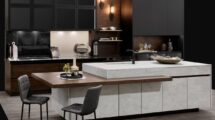Creating the perfect lighting in your home can significantly influence its overall ambiance and functionality. Whether you’re aiming to enhance the coziness of your living room, boost the productivity of your home office, or create a calming sanctuary in your bedroom, the right lighting choices are essential. This guide will walk you through various lighting techniques and tips to help you achieve a harmonious and well-lit home environment.

Understanding the Basics
Lighting in your home primarily falls under three main types: ambient, task, and accent lighting. Ambient lighting provides the general illumination needed for daily activities and sets the overall level of light in a room. This can be achieved through ceiling-mounted fixtures, chandeliers, or wall-mounted fixtures.
Task lighting, on the other hand, is more focused and is intended to assist in specific tasks such as reading, cooking, or working at a desk. Desk lamps, under-cabinet lights in the kitchen, and vanity lights in bathrooms are all examples of task lighting. Accent lighting is used to highlight particular objects or architectural features in your home. Think of spotlights on artwork or track lighting to showcase a beautiful bookshelf. Whether you’re looking for ceiling lights, wall sconces, or table lamps, understanding these different types of lighting will help you make the right choices for your specific needs. It’s also crucial to consider the color temperature of your light bulbs, with warmer tones being more suitable for living spaces and cooler tones for areas that require better visibility.
Living Room
In the living room, it’s important to create a warm and flexible lighting scheme that can adapt to various activities, from casual lounging to entertaining guests. Begin with a central ambient light fixture like a chandelier or overhead ceiling light to establish the general lighting. Complement this with additional layers of light, such as wall sconces or floor lamps, to create depth and soften shadows.
Consider adding dimmable lights, which allow you to adjust the brightness according to the occasion and mood. Task lighting, such as reading lamps beside sofas or accent lights to highlight artwork, can further enhance the versatility of your living room’s lighting design. This layered approach ensures a cozy and inviting atmosphere while providing the adaptability needed for different functions.
Kitchen
The kitchen is a high-traffic, multifunctional space that requires a blend of bright, focused light and warmer, more inviting tones. Start with ambient lighting from recessed lights or a central fixture. Ensure you have sufficient task lighting in key areas, such as under-cabinet lights for countertops, pendant lights over the island, and focused lighting for the sink area.
Consider incorporating accent lighting to highlight architectural features or decor elements like open shelves or cabinets with glass doors. Combining different lighting sources adds layers and dimension to the kitchen, making it a functional workspace by day and a warm, inviting space by evening.
Bedroom
In the bedroom, the aim is to establish a haven of relaxation and rest. Choose soft, warm ambient lighting like ceiling fixtures with diffusers or wall-mounted sconces to create a serene atmosphere. Position task lighting such as bedside lamps for reading or focused activities without overpowering the room.
Accent lighting can be used to highlight decorative elements, such as artwork, or to create focal points, like a beautifully made bed. Consider adding dimmable lights or smart bulbs that allow control over the brightness and color temperature to tailor the ambiance for various activities, from winding down at night to waking up in the morning.
Home Office
Effective lighting can significantly influence productivity in your home office. Start with bright, uniform ambient lighting using ceiling fixtures or wall-mounted lights to ensure the whole room is well-lit. Since the bulk of work involves focused activities, task lighting is crucial. Desk lamps with adjustable arms and brightness levels offer the flexibility needed for intricate tasks.
Reduce eye strain by minimizing glare and shadows; position lights to avoid shining directly on computer screens. Accent lighting can help create a focused environment by highlighting bookshelves or art pieces, adding character to your workspace without distracting from the primary task at hand.
Bathroom
A well-lit bathroom requires a mix of functional and flattering lighting. Ambient lighting can be provided by ceiling fixtures, while task lighting is critical around the vanity area. Use side-mounted sconces or light strips on either side of the mirror to eliminate shadows and provide even illumination for grooming tasks.
Consider adding dimmable lights or color-changing LEDs around the bathtub or shower area to create a relaxing spa-like environment. Layering different types of lighting ensures the bathroom is both practical for daily routines and pleasant for unwinding after a long day.

Creating a harmonious home through lighting takes a layered approach and considers the specific needs of each room. Understanding the basics of ambient, task, and accent lighting and incorporating various sources with dimming capabilities can help you achieve a well-lit and inviting home environment that suits your lifestyle. Remember to also consider energy-efficient options like LED bulbs for cost savings and environmental sustainability.






